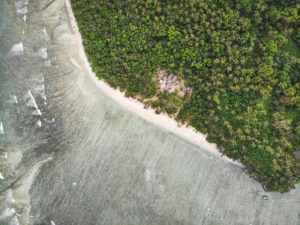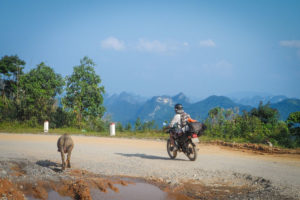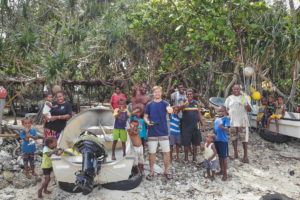How to Pack Light For a Week or More of Travel. Solved.
Every time I travel my bag is full to its breaking point. Zippers won’t close, my clothes won’t fit back in, and daily repacking can take up to half an hour! I always wish that I’d just pack light for a week of travel.
To help, guest blogger Thomas Carney gives us 8 tips on how to pack light for a week or more of travel. In fact, these principles can actually apply to traveling for a month or more! A trip like my 10 days traveling around Taiwan is a perfect example.

You never wish you brought more stuff with you when traveling. In fact, I’d argue that the fewer things you bring with you, the more fun you’ll have on your trip.
The analogy I always tell people is that you wouldn’t walk around your own city with 45 lbs on your back, so why would you do that when you’re traveling?
I travel with a 10 lbs (4.5 kg) in a 19 L backpack. That’s a little extreme, but you can take the same principles and cut down your luggage to something that works for you.
1. Pack Light with Carry On Only

The first tip on how to pack light is to limit what you can pack. Go with a smaller bag.
Not only will your back thank you, but you’ll save a ton on the exorbitant checked baggage fees that many budget airlines charge.
You’ll also avoid the nightmare of losing your luggage. This can get complicated if you’re not staying at one location for very long and on the move.
Obviously, this constraint will force you to radically reduce your luggage to meet the carry-on requirements of airlines. Airlines generally allow around 22 lbs (10 kg), but can be lower.
For example, Air Asia has a limit of 15 lbs or 7 kg for carry-on luggage.
2. The YAGNI Principle or Why You Won’t Need Half Your Stuff

YAGNI is short for “You Ain’t Gonna Need It”. That’s the case for most “what if” items that people pack.
You really don’t need to pack stuff like suncream, shampoo, insect repellant or umbrellas unless you’re heading to the deepest jungle of Thailand. One exception is my photography gear, doesn’t apply there.
The vast majority of destinations in Asia and Europe offer these items at every corner store or pharmacy.
In fact, recently a star up in China launched a service where you can “rent” umbrellas by the hour on demand (albeit with an unsuccessful start of promptly losing all 300,000 umbrellas).
But what happens, you might ask, if you really do need something on your trip?
3. Keep a $200 Settling Fund on Hand

Instead of buying items for every conceivable contingency upfront, you can save the money and keep $200 on hand for spending on things you need as they occur.
Like me, did you make a poor decision and rent a hut just beside a stagnant lake on the Caribbean island of Guadeloupe? You can go out and buy an armful of the strongest insect repellent from the pharmacy to ward off the dark clouds of mosquitoes.
The beauty is that you have an insurance fund for buying what you need when you need it and you don’t have to carry it all around while traveling.
After all, $200 dollars is a lot lighter than tubs of sunscreen, umbrellas, and flip-flops.
4. Borrow, Rent or Share as Much as Possible

Airbnb may have kicked off the sharing economy, but the principle has shared to tons of other sectors.
Now, you can rent someone’s RV for a weekend directly from them at a very reasonable rate. Or you can rent out your dream boat just for a couple of days, splitting the cost with a group of friends.
Personally, I usually rent sports gear such as surfboards, stand-up paddle boards or kite surfing gear on location.
Alternatively, you can ask in the forums on sites such as CouchSurfing whether someone local has some gear you could borrow in return for a small fee or a round of drinks.
5. Pack the Right Clothing
I try to build a wardrobe of clothing that works together as a system. That means I can use them in a variety of situations from cold, windy Iceland to traveling through tropical Thailand.
For example, you can layer clothing together. If it’s warm out, I’ll just wear a t-shirt. Then I’ll add a hoodie if it gets colder. Finally, I’ll add a lightweight insulated jacket on top for very cold weather.
If it’s raining, I’ll add my ultralight rain jacket on top.
In terms of fabric, I swear by merino wool in general thanks to its insulating and antibacterial properties. I wrote a guide to merino wool t-shirts if you want to learn more.
For my pants, I have a pair of Outlier pants that were designed for use on a bike, but also look good in an office.
In terms of shoes, I wear a pair of Chelsea boots, as they’re good enough for small hikes but also look good in a restaurant.
6. Bring One Ridiculous Item

Feel free to ignore this one, but I always bring one ridiculous item with me. In my case, that’s an Aeropress coffee maker, as I feel it makes the finest coffee short of lugging around a 200 lbs stainless steel Italian espresso machine.
It adds a touch of luxury to any situation, regardless of whether I’m staying in an overcrowded dorm room or a cockroach-infested beach hut.
Recently, I met a Canadian Russian digital nomad called Vladimir who traveled very minimalist with the sole exception of a whip. It’s was quite a story where that led him.
7. Consider Your Towel
If you want to pack light while traveling you have to consider all your items. A towel is an easy reduction.
Most resorts or hostels will offer a towel with your stay. Generally, you can leave this behind. However, if you’re getting further off the beaten track or going out camping, try to pack a microfiber towel. They are lighter, dry quicker and work just as well.
8. Wash One, Wear One

This last tip on how to pack light is for hardcore ultralight travelers. The idea is that you have two pieces of all your clothing: t-shirts, socks, underwear and so on.
Every day you wash (usually hand wash) one pair while wearing the other. This way, you’re never carrying around a bag full of dirty or clean clothing, and yet you always have clean clothes to wear each day.
If you master this one, you can not only pack light for a week, but for months of travel on end.
Conclusions
That wraps up the 8 principles that I use for ultralight travel. Do you have any tips on how to pack light for a week or more of travel? I’d love to hear them below in the comments.

About the Author: Thomas Carney is an ultralight traveller based in Berlin, Germany. He writes about minimalist travel and gear lists.












